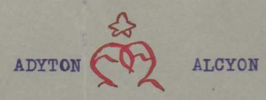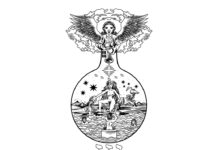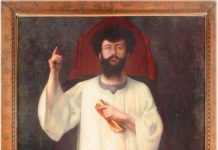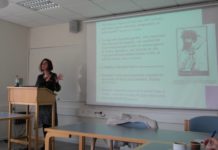In her essay “Yetzirah,” Steffi Grant explains how sacred geometry is the manner in which Spirit can “descend into matter without essential loss”: “The ancients, postulating that God geometrized, used architecture to fix eternal doctrines in earthly edifices.”[1] Grant describes the book The Canon by William Stirling and how “geometric abstractions, plans and sacred diagrams embodying eternal verities” have been used throughout history to “form the skeleton of actual buildings, so that—as [Stirling] says—the visible body of the macrocosm or universe would make the beholder revert immediately to the Body of Truth of which it formed the outward expression.” The “Body of Truth” is the essence of being, but it is also Adam Kadmon, the macrocosmic man, “whose measurements are those of the stars and planets, whose gestures and attitudes are depicted according to the ancient canonical rhythm of eternal things.”
In his own book on sacred geometry, The Anatomy of the Body of God, Frater Achad (Charles Stansfeld Jones) describes how the Qabalistic Tree of Life can be “developed into a complicated geometric figure ‘completely filling all known space.’” Expanding on the training he received in the A.’.A.’., Achad was convinced “that the Tree of Life was capable of forming a symbolic basis for every idea in the cosmos”—even building construction. According to Grant, Achad “appealed to architects to use [the Tree of Life] as a ground plan for a perfect and universal temple.” Through this practical application of the universal sacred geometry of the Tree, Achad believed that a new universal order could be established that would allow humanity to “start to build a ‘Living Temple, not made with hands, eternal in the Heavens’—upon Earth.”[2]
The universal temple would be the focal point of this universal order, an image of the Macrocosm and of Adam Kadmon realized in the terrestrial world. As Achad wrote in Anatomy, humanity must create “the First Great Temple built directly upon the Nature Formative Plans of the Grand Architect of the Universe. In such a Temple all Nations and Peoples might well meet to give praise to the One Whose Absolute Wisdom and Supreme Intelligence has built this Universe, and made it possible for created Man to comprehend its hidden Designs and to become a conscious co-operator in the Divine Plan.”[3]

Like the astrological City of Adocentyn in the Picatrix, or Renaissance Hermetist Tommaso Campanella’s City of the Sun, Achad’s Qabalistic temple would be an earthly talisman of the Macrocosm, allowing its visitors to absorb the wisdom of the Grand Architect of the Universe and to become “conscious co-operators in the Divine Plan”—which, for Achad, involved the creation of a unified organization of universal humanity, a utopian civilization built on Hermetic and Qabalistic lines.
This utopian aspiration is clear in Achad’s next appeal in Anatomy, to world religious leaders. Achad proclaims that a “Universal Teaching is needed, based upon simple and intelligible lines. A teaching that at once conforms with true Science and with the Universal experience of Humanity.”[4] Because of modern communication, which allows people to communicate with those on the other side of the planet within moments, “There is no longer any reason why a Universal Teaching should not be obtained and given to all humanity.”[5] Achad concludes by arguing for the universality and unity of Truth: “I do not say that all humanity should be taught exactly alike, but I do say that there is but One Truth, and that One Truth is back of every exterior organization, however differently it may be interpreted.”[6]
So we see here Frater Achad’s proposed method, through sacred architecture and Qabalistic concepts—many of which were anticipated by Stirling in his book on sacred geometry—of accomplishing a Universal Reformation of human society and religion. Achad’s universal temple would serve as both a center of learning and as a talismanic image whereby Microcosm could be joined to Macrocosm, “the visible body of the macrocosm or universe” seen in the temple making “the beholder revert immediately to the Body of Truth of which it formed the outward expression,” to use Steffi Grant’s phrase. Of course, the drive for Universal Reformation has been a part of esoteric ideas for centuries—the Hermetists of the Renaissance and the Rosicrucians of the early modern period all proclaimed the need for a universal natural religion based on astrological and Hermetic principles, and Campanella’s City of the Sun outlines what such a society might look like and how it might function.[7]
Writing between the world wars, Achad understood the deep need for such a Universal Reformation. As he explains in Anatomy, “An understanding of the fundamental working principles of the Universe, and of the Working Plans of the Great Architect, is essential to a clear vision of what is needed to overcome the present difficulties with which mankind is confronted on every side. Things must be looked at from the point of view of the Whole, rather than that of the Part, if a proper Order and Arrangement is to be brought about.”[8]
Of course, Frater Achad never built his universal temple, or accomplished the general reform of human society. In fact, The Anatomy of the Body of God was his last published book, and after his break with Aleister Crowley in the mid-1920s he entered a period of relative quiet as far as public life was concerned. As Steffi Grant concludes, “his was to be a temple not built by hands; he was not like Gaudi, who lived to realize his dreams, even if only in fragmentary form.”

But this is not quite the whole story. The Anatomy of the Body of God was published in 1925; at that time, Frater Achad continued to advance in the hierarchy of the Universal Brotherhood—also known as the Integral Fellowship or the Mahacakra—an obscure secret society he had joined along with many other American occultists in the early 1920s.[9] Within two years, he would convert to Roman Catholicism, and in another few years he would become the leader of the U.B., its Mahaguru. Steffi Grant is right that Achad would not live to realize his dream of a physical universal temple that reflects the “visible body of the macrocosm or universe,” but she is unaware of the details of Achad’s work in the next decade of his life, which he dedicated to the Integral Truth manifested by the Mahacakra—a universal society meant in its teachings and organization to serve as an image of the Integral Macrocosm. As Achad explains in one of his unpublished U.B. letters, “The M. [Mahacakra] in its largest sense represents The Great Circle of the Macrocosm with all creatures as its periphery and God Himself as its Centre.”[10] In another letter, Achad describes how the complex organizational schema of the U.B. is itself an image of the cosmos, and of the utopian human society:
“It is a fact that in m. we have been taught that there is a certain correspondence between things above and below, within and without, etc. etc., if we could only see and understand such correspondences. This is also the ancient Hermetic and Occult tradition … It is a fact that the true M. claims to be the whole circle of existences, with God at its Centre … It is a fact that the organized m. was designed to represent innumerable correspondences between the atomic structure in the aether … the cells of the body … and so on until the Panjurisdictions [areas of administration in the U.B.] were in perfect accord with the Ideal Human Society on the one hand and the Starry Heavens on the other.”[11]
Like the sacred architecture described by Stirling, the experience of the structure of the M. is meant to “make the beholder revert immediately to the Body of Truth of which it formed the outward expression.” The Integral Teaching of the U.B. fulfilled the desire for a universal teaching that Achad expressed in Anatomy, and one of its goals included the creation of a utopian universal society, based—like Campanella’s City of the Sun or the Picatrix’s City of Adocentyn—on the divine order embodied in the Macrocosm. In a letter to his student W.T. Smith, Achad explained that the goal of the U.B. was “the Universal Terrestrial Realization of the Ideal, the deliberate carrying into effect and bringing to full fruition of the Divine and Macrocosmic Purposes,” and that this would be accomplished by “the study and diffusion of the Integral Truth and the methods of attaining and verifying it,” which would result in “the building up of the Integral Fellowship which is Humanity itself so far as it has become normally & organically united.”[12] In other words, the goal of the U.B. was a universal human society organically united around the Integral Teaching, imparted through a comprehensive correspondence course which formed a talismanic image of the Integral Macrocosm.
So if Frater Achad was never able to build a physical universal temple on the Qabalistic lines of his Anatomy of the Body of God, he did indeed participate in the building of a textual universal temple, through the epistolary methods of the Universal Brotherhood. In Achad’s lifetime, the work of the U.B. was carried out through a vast network of letter writing and a secretive pyramidal structure that one historian has compared to a “Chinese box.” In this, Achad was following a stream of occult tradition that went back to the original Rosicrucians of the sixteenth century. When the Renaissance Hermetists failed to complete their physical City of the Sun, their universal image of the Macrocosm—Campanella himself spent much of his life in the prisons of the Inquisition for his many attempts—the Rosicrucians instead built the talismanic tomb of Christian Rosenkreutz in the literary form of the Fama Fraternitatis. Arguments over the physical existence of the tomb, or whether the Rosicrucian furor was a literary plot rather than a real secret society, are not important here—the fact is that the primary impact of C.R.C.’s tomb throughout history, on untold numbers of people, has been in literary form. It is a textual image of the Macrocosm that has had a psycho-magical effect on its readers, sparking an entire esoteric movement with a major (if occult) impact on human society.
For the rest of his life, Frater Achad would work on a similar project: developing, organizing, and leading the Universal Brotherhood in the hope of creating a universal society that could change the course of human civilization, an attempt to build a “Living Temple, not made with hands, eternal in the Heavens”—upon Earth.[13]
[1] Steffi Grant, “Yetzirah,” in Steffi and Kenneth Grant, Hidden Lore: The Carfax Monographs (1989).
[2] Charles Stansfeld Jones (Frater Achad), The Anatomy of the Body of God, preface (1926).
[3] Ibid., ch. XII.
[4] Ibid., ch. XII.
[5] Ibid., ch. XII.
[6] Ibid., ch. XII.
[7] See, for example, Manly P. Hall’s Orders of Universal Reformation (1976) for more information on this topic.
[8] Anatomy, ch. XII.
[9] The story of Frater Achad’s, and other Thelemites’, involvement with the Universal Brotherhood is told in Martin P. Starr’s The Unknown God: W.T. Smith and the Thelemites (2003). For a (somewhat incomplete) summary of the U.B.’s history and teachings, see Frater Taos, “Charles Stansfeld Jones and the Universal Brotherhood,” in Success is Your Proof: One Hundred Years of O.T.O. in North America (2015).
[10] Jones writing as Adyton-Alcyon, The Silver Postmesospheric – The Pivotal Man, in the author’s collection. I am in the process of transcribing and editing the Adyton-Alcyon documents, which I hope to eventually publish with commentaries.
[11] Jones writing as Vajrasattva Guru to Pushpajaya Cela (1935), in the author’s collection.
[12] Jones to W.T. Smith, March 12, 1925, WTS Papers, cited in Starr, The Unknown God.
[13] The Universal Brotherhood and Pansophy have much in common, at least in terms of their utopian visions and emphasis on universal wisdom. In the 1920s, Jones would become the North American representative of Heinrich Traenker’s Collegium Pansophicum, which he would incorporate into the U.B. in 1936 as an outer order (and as an attempt to bring a legitimate Rosicrucian lineage into the U.B.). The Catholic Achad would also include a major role for the Virgin Mary in his U.B. writings; there are parallels here with the role of Sophia in Pansophy and in Jacob Boehme. I hope to write more on this topic in the future.










